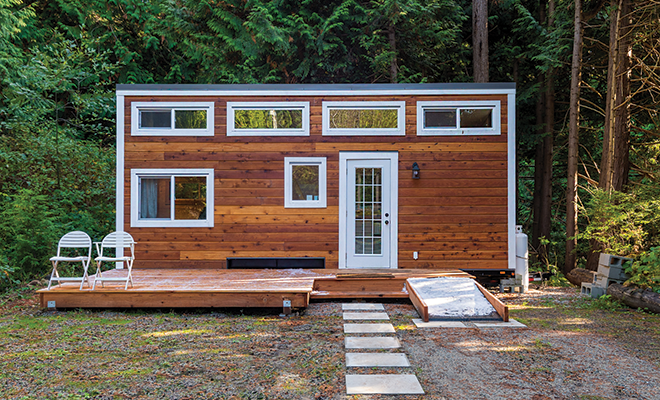
Tiny Houses: A Support for Housing Insecurity?
Tiny houses have been a real estate trend on television and social media for the past several years. Soaring home prices and desire for a minimalist lifestyle have fueled interest in homes that are not much bigger than a large walk-in closet.
With an area of 100 to 400 square feet, these diminutive dwellings provide the comforts of home on a very reduced scale. While offering the promise of freedom and flexibility, they require serious downsizing that many homeowners find difficult to achieve. The minimalist lifestyle required to live in a tiny home is not for everyone.
The severe lack of affordable housing across the country has led to a new use for tiny houses. California, Missouri and other states are constructing tiny house communities for those experiencing chronic homelessness. It’s part of the “Housing First” philosophy that works to move people from the street to independent living instead of relying on shelters or hard-to-find transitional housing. Residents of many of these new settlements receive meals, counseling services and drug addiction treatment. According to experts, this additional support is key to breaking the cycle of chronic homelessness.
The biggest benefits of a home are privacy and security. Most shelters aren’t meeting these basic human needs. A tiny house offers private space and a door that locks. Unlike a tent, it also serves as a shelter from extreme weather. A tiny house also offers security for persons who are uncomfortable in traditional shelters.
In Kansas City, the Veterans Community Project has constructed a village of 49 tiny homes for U.S. military veterans. The homes range from 240 to 320 square feet. Just as important as a roof over their heads are the services provided by the Veterans Outreach Center next to the village. Dental care, counseling and veterinary services for pets are available free to residents. The program’s goal is for occupants to become independent within two years.
In Los Angeles, often called ground zero for the nation’s homelessness problem, many politicians see tiny houses as a low-cost alternative to other forms of public housing. The Los Angeles Times reports that the average cost of building a unit of supportive housing is $600,000 compared to $68,000 for a tiny house for two. Parking lots and other public spaces now host communities such as the Arroyo Seco Tiny Home Village, home to 117 small cabins.
In St. Louis, Missouri, city leaders recently transformed a former RV park into a tiny house community. Dubbed Jefferson Spaces, the community’s 50 colorful homes serve as transitional housing. Residents have access to meals, Wi-Fi and job placement services. In exchange for free rent, they are expected to find work and permanent housing so they can leave the community within three to six months.
One of the oldest tiny house communities for the homeless is Community First! Village in Austin, Texas. The 51-acre master-planned development offers permanent housing for people who have been living on the streets. Besides 100 RVs, the village is home to 130 micro-homes. Five outdoor cooking facilities and five laundry/restroom/shower buildings are available for residents. Amenities include a community organic garden and a market, car repair service, cinema and other businesses. Mobile Loaves & Fishes, the program that developed and maintains the community, seeks to expand until 500 RVs and homes are available.
The movement to provide people experiencing homelessness with tiny houses is not without critics. Tiny houses for the homeless are simpler than the custom dwellings featured on TV shows. Instead of loft bedrooms and miniature kitchens and bathrooms, most contain a single room with two single beds or a bed and desk. Communal bathroom facilities take the place of private bathrooms. Some homeless advocates have compared the houses to human storage sheds and say they are a short-term solution to a long-term problem.
Of course, money spent housing persons with housing insecurity is an enormous concern for most cities. The overall cost of the tiny home may be less, but the construction costs are higher. According to Rocket Mortgage, the average cost of building a traditional house is $150 per square foot, compared to $300 per square foot for a conventional tiny house. This is an important consideration for cities that want to build or purchase entire communities of tiny houses. Connection to utilities and scaled-down furniture and appliances are additional costs to consider.
Critics also say that most tiny home communities put too many restrictions on residents. Many favor safe haven shelters that are open 24/7 and accept individuals without restriction. Shelters are typically more expensive to build and operate than tiny home communities but can serve more people.
The issues swirling around tiny houses for persons experiencing housing insecurity are as complex as the problem of housing insecurity itself.
Sources: curbed.com, mlf.org, kcur.org and stlpublicradio.org.







